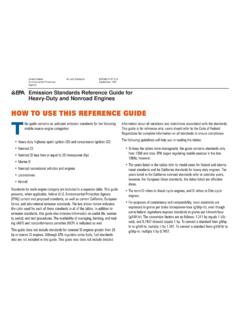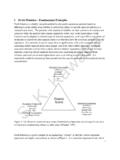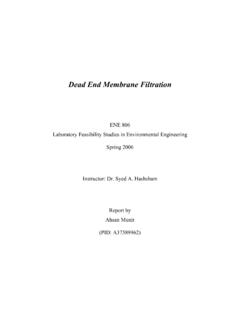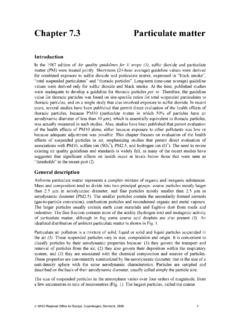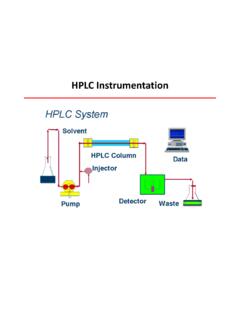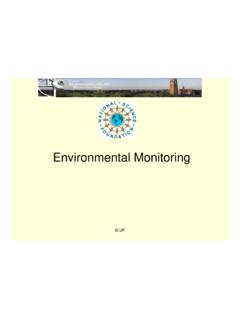Transcription of Air Pollution Control Equipment - US EPA
1 1 Air Pollution Control Equipment22 Overall ProcessAir Pollution Control DeviceProcessTreatmentStackMonitorsThis module will focus on air Pollution Control Equipment . The flow diagram presented in this slide shows schematically a process that might be the subject of MACT EEE, the hazardous waste combustor MACT. The process would be such as a chemical process. The treatment would be the part of the air Pollution Control that combusted the hazardous waste, such as an incinerator, solid or liquid fuel boiler, or cement or light aggregate kiln. The air Pollution Control device would be one that follows the combustion device to remove hazardous constituents from the gas stream before being released to the atmosphere.
2 This module will discuss various air Pollution Control EEE Air Pollution Control (APC) Devices Function HAP Control HAP Organic, Acid, Particulate APC Devices: Dry and Wet Particulate Control Device Baghouse (Fabric Filter) Wet and Dry Gas Scrubber Electrostatic Precipitator (ESP) Activated Carbon Adsorption, Bed and InjectionThe function of air Pollution Control devices generally and for the MACT EEE rule specifically is to Control or remove hazardous air pollutants (HAP) from the off gas stream before being released to the atmosphere. The HAP to be controlled can be organic, acidic, or a particulate.
3 Some types of air Pollution Control devices that will be discussed are Dry and Wet Particulate Control Devices, Baghouses (also called Fabric Filters), Wet and Dry Gas Scrubbers, Electrostatic Precipitators (ESP), and Activated Carbon Adsorption, Bed and to Control Particulate Matter1. Cyclone Separator2. Fabric Filters3. Cartridge Filters4. Electrostatic Precipitators (ESPs)5. High-Efficiency Particulate Air (HEPA) Filters6. Venturi Scrubber7. Fiber-Bed Mist-Eliminator (used with Wet Scrubbers)Air Pollution Control devices used to Control particulate matter are: Cyclone Separators, Fabric Filters, Cartridge Filters, Electrostatic Precipitators (ESPs), High-Efficiency Particulate Air (HEPA) Filters, Venturi Scrubbers, and Fiber-Bed Mist-Eliminators (used with Wet Scrubbers).
4 55 Devices to Control Gaseous Pollutants1. Wet Gas Scrubber2. Packed-Bed Scrubber3. Adsorbers (Activated Carbon)4. selective Catalytic Reduction (SCR)5. selective Non-Catalytic Reduction (SNCR)Air Pollution Control devices used to Control gaseous pollutants are: Wet Gas Scrubbers, Packed-Bed Scrubbers, Adsorbers (Activated Carbon), selective Catalytic Reduction (SCR), and selective Non-Catalytic Reduction (SNCR).66 APC Technical Considerations One type of APC device may be more appropriate than another Incinerator is more appropriate than flare for compounds containing halogens because acids formed by combustion may be removed by scrubber following incinerator, whereas flare cannot be equipped with scrubber to remove acid gasThere are technical considerations for air pollutant Control devices since one type of APC device may be more appropriate than another.
5 An Incinerator, for example, is more appropriate than flare for compounds containing halogens because acids formed by combustion may be removed by scrubber following incinerator, whereas flare cannot be equipped with scrubber to remove acid Technical Considerations Table below provides qualitative description of different APC devices as they apply to varying stream and flow characteristics Table only can be used as general guideline because it only provides quick qualitative snapshots of APC devices and conditions All technical aspects should be considered thoroughly when evaluating APC devicesThe Tables shown in slide that follow provide a qualitative description of different APC devices as they apply to varying stream and flow characteristics.
6 These Tables only can be used as general guideline because they only provide quick qualitative snapshots of APC devices and conditions. All technical aspects should be considered thoroughly when evaluating APC Considerations Stream CharacteristicsDevice ranking is from Excellent (A) to Poor (F)High MoistureHigh VolumeHigh TemperatureHigh ConcentrationLow ConcentrationDeviceBAAAAI ncineratorC-DAAD-FAFlareD-FD-FD-FA-BD-FC ondenserD-FB-CC-FD-FA-CCarbon AB-CB-FC-DB-CScrubber B-DA-DAD-FA-DESP B-FAA-BD-FA-BBaghouseA-BAA-CB-CB-CCyclon e The table compares the stream characteristics for a Cyclone, Baghouse, ESP, Scrubber, Carbon Adsorber, Condenser, Flare and Incinerator.
7 For low concentration streams, a baghouse, ESP, carbon adsorber, flare or incinerator are shown a possible good candidates. For a high concentration stream, a condenser and an incinerator are good candidates, for high temperature or high volume streams, all but scrubber, carbon adsorber and condenser are good candidates. For high moisture streams, a cyclone or a scrubber are the best Considerations ContaminantsDevice ranking is from Excellent (A) to Poor (F)* If followed by scrubberHigh Vapor PressureSize < 10 MicronsSize > 10 MicronsCondensible ParticulateInorganic AcidsHalogenatedDeviceABAAB-DB*Incinerat orAAD-FFFlareD-FD-FD-FD-FD-FD-FCondenser B-DFFD-FD-FA-CCarbon A-CA-BAB-CA-BA-FScrubber B-DA-DESP A-BAB-FBaghouseD-FC-DB-DCyclone The table compares the contaminant characteristics for a Cyclone, Baghouse, ESP, Scrubber, Carbon Adsorber, Condenser, Flare andIncinerator.
8 For streams that are halogenated, a scrubber or carbon adsorber are good candidates. Note that an incinerator is a good choice if followed by a scrubber. For inorganic acids in the stream, a scrubber is the best choice. For condensible particulate, a flare or incinerator are good choices. For particulate that is small, that is less than 10 microns, a baghouse, ESP, scrubber, or incinerator are good choices, whereas for later particulate, a baghouse or scrubber are the best choices. For high vapor pressure contaminants in the stream, a scrubber, flare or incinerator are the best Considerations Source of ContaminantDevice ranking is from Excellent (A) to Poor (F)Variable Flow RateContinuousNon-Continuous (Batch)DeviceBACI ncineratorAAAF lareD-FD-FD-FCondenserCA-CCCarbon B-CA-CB-CScrubber B-DA-CB-DESP AAAB aghouseAAAC yclone The table compares the characteristics of sources of contaminant for a Cyclone, Baghouse, ESP, Scrubber, Carbon Adsorber, Condenser, Flare and Incinerator.
9 For non-continuous or batch processes, a cyclone, baghouse, and flare are good candidates. For continuous processes, all but a condenser could be considered for application. For a variable flow rate process and therefore variable contaminant concentration, a cyclone, a baghouse and a flare are good SeparatorThis slide shows how a cyclone separator works. As the schematic shows, dirty gas enters on the side at the top, normally at an angle, then swirls around the interior of the cyclone spinning particulate to the sides of the cyclone. The removed dust slides to the bottom of the cyclone and exits at that point.
10 The gas with reduced particulate exits the top of the SeparatorThis slide shows other schematics of cyclones with devices to aid the swirling action of the Description Used for course particulate removal Typically used as pre-filter Can function at high temperatures without moving parts Efficiency greatly depends on particle size Inlet swirling action moves suspended particles to walls then drops outCyclone separators are primarily used for course particulate removal. Mostly they are used as a pre-filter to another filter to remove the smaller, finer particulate. Cyclones have no moving parts and typically can handle high temperatures without difficulty.




